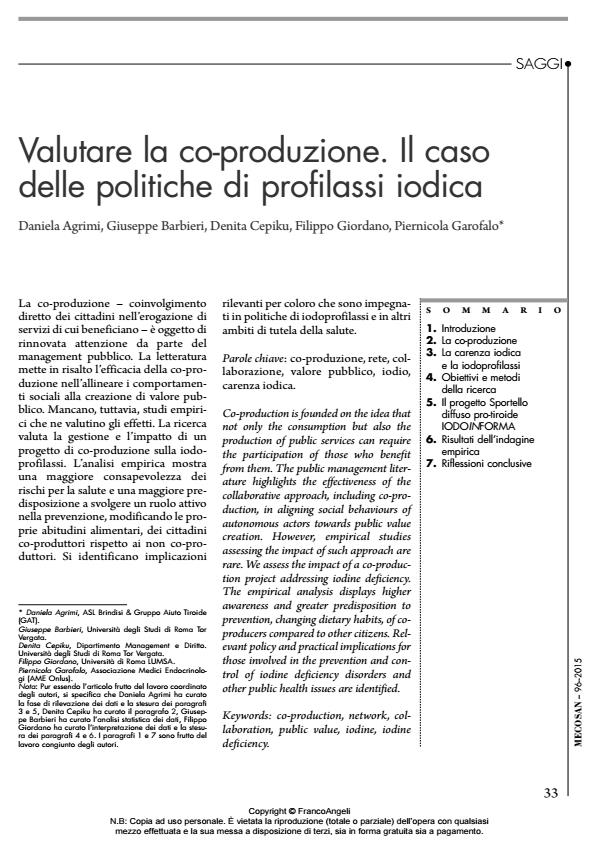Valutare la co-produzione. Il caso delle politiche di profilassi iodica
Journal title MECOSAN
Author/s Daniela Agrimi, Giuseppe Barbieri, Denita Cepiku, Filippo Giordano, Piernicola Garofalo
Publishing Year 2016 Issue 2015/96
Language Italian Pages 26 P. 33-58 File size 320 KB
DOI 10.3280/MESA2015-096003
DOI is like a bar code for intellectual property: to have more infomation
click here
Below, you can see the article first page
If you want to buy this article in PDF format, you can do it, following the instructions to buy download credits

FrancoAngeli is member of Publishers International Linking Association, Inc (PILA), a not-for-profit association which run the CrossRef service enabling links to and from online scholarly content.
Co-production is founded on the idea that not only the consumption but also the production of public services can require the participation of those who benefit from them. The public management literature highlights the effectiveness of the collaborative approach, including co-production, in aligning social behaviours of autonomous actors towards public value creation. However, empirical studies assessing the impact of such approach are rare. We assess the impact of a co-production project addressing iodine deficiency. The empirical analysis displays higher awareness and greater predisposition to prevention, changing dietary habits, of coproducers compared to other citizens. Relevant policy and practical implications for those involved in the prevention and control of iodine deficiency disorders and other public health issues are identified.
Keywords: Co-production, network, collaboration, public value, iodine, iodine deficiency
- La gestione integrata delle malattie croniche: un modello biosociale per le endocrinopatie Daniela Agrimi, Linda Lombi, Antonio Maturo, in SALUTE E SOCIETÀ 3/2017 pp.167
DOI: 10.3280/SES2017-003013 - La co-production in sanità: un'analisi bibliometrica Floriana Fusco, Marta Marsilio, Chiara Guglielmetti, in MECOSAN 108/2019 pp.35
DOI: 10.3280/MESA2018-108003 - PARTICIPAÇÃO DO CIDADÃO NA NOVA GOVERNANÇA PÚBLICA: UMA REVISÃO SISTEMÁTICA DA LITERATURA Felipe Moura Oliveira, Thiago Costa Holanda, Joiciane Rodrigues De Sousa, Maria do Socorro Silva Mesquita, Rogeane Morais Ribeiro, Francisco Roberto da Silva Mesquita, Thiago Limoeiro Ricarte, Karina Valdez Ribeiro, in REVISTA FOCO /2024 pp.e4300
DOI: 10.54751/revistafoco.v17n1-180
Daniela Agrimi, Giuseppe Barbieri, Denita Cepiku, Filippo Giordano, Piernicola Garofalo, Valutare la co-produzione. Il caso delle politiche di profilassi iodica in "MECOSAN" 96/2015, pp 33-58, DOI: 10.3280/MESA2015-096003